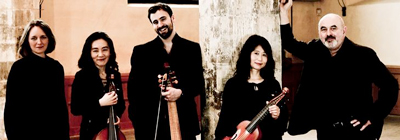by Nicholas Jones

At the death in 1695 of Henry Purcell, arguably the greatest of composers for viol consort, those instruments — treble, tenor, and bass — swiftly fell out of favor, displaced by their louder and more versatile cousins, the violin, viola, and cello. In the 20th and 21st centuries, the viol consort has experienced a rebirth parallel to the rediscovery of Baroque music, a new exploration of the subtle and humane sonic world of consort music.
At the center of that rebirth is the British viol consort Fretwork, now celebrating its 30th anniversary with an extensive North American tour that included a stop last week on the Cleveland Museum of Art’s Performing Arts series. The group’s name refers to one of the viol’s distinguishing features. Frets, as on a guitar, run down the fingerboard and allow the performers to play with a wonderful precision of intonation. Five players constitute Fretwork, led with a gentle hand by one of the consort’s founders, Richard Boothby. He, Asako Morikawa, Reiko Ichise, Emily Ashton, and Sam Stadien perform the complicated and often daunting intricacies of viol music with confidence and clarity.
The concert opened with four pieces from 16th-century England. In Gartner Auditorium — a much larger space than this music was intended for — these pieces at first seemed acoustically distant, but the ear quickly attuned itself to the prominent chiff that begins each new bowing on the viol, and the quiet rise and fall of the sound. The dynamic range is considerably smaller than we are used to in, say, a string quartet.
It also took time to understand the music compositionally. Much of it is constructed around a plainsong played in long notes by a single musician, the others playing lines with increasing harmonic and rhythmic energy around that steady core. One of the most popular plainsongs was the tune known as “In Nomine,” derived from an early 16th-century mass by John Taverner. Fretwork played that section of Taverner’s mass as the first piece on the program.
Quickly shedding its liturgical robes, the “In Nomine” tune showed up in street clothes in the next piece, Crye by Christopher Tye, imitating the sounds of London street vendors ornamented with ear-stretching rhythmic augmentations. A third In Nomine piece followed, this one by Robert Parsons, the tune now embellished with florid sixteenth-note runs.
Fretwork next pushed our ears even further with a completely different kind of piece. The ensemble has successfully broadened its repertoire beyond the Renaissance by featuring a number of contemporary compositions. River Mouth Echoes, by Norwegian composer Maja Ratkje, was commissioned in 2000 by a Danish viol consort. This extensive piece creates a very different soundscape from the “In Nomine” works, but with equal subtlety and delight. Ratkje writes in a modernist style, demanding a range of extended techniques from the performers and an active imagination from the listeners.
An episodic piece, River Mouth Echoes seems to present a series of musical evocations of the pull and push of a tidal estuary, where water, air, and land are moved by powerful but often invisible forces. There are moments filled with skittery motions (the bows thrown chatteringly against the gut strings), with sudden assertions of change in the great growling noises on the bass viols, whispery high, tight chords with the bows barely contacting the strings, and notes played with enormous, wide vibrato — a mode totally uncharacteristic of historic viol playing.
After intermission, the program resumed with another contemporary piece, commissioned by Fretwork in 2015 from distinguished young American composer Nico Muhly. Slow takes a different approach to modernism than the Ratkje, befitting its title and its explicit adherence to the “In Nomine” form. The slowness of the title implies no indolence or lethargy. Within its restricted range of pitches and dynamics is a tremulous and insistent kind of energy, culminating in a gorgeous chord that fades away to reveal a single note on the tenor viol — a kind of revealed center in the deliberate and elaborate shiftings of the rest of the piece.
A three-part “sett” from the 1640s by William Lawes brought the music of the historic viol consort back to our ears with a rich vitality of leaping melodic lines and surprising harmonies. This was followed by a 20th-century In Nomine by British composer Gavin Bryars, full of the dissonant chordal “crunches” that viol music has always delighted in.
The program ended — as it almost certainly had to — with the great Henry Purcell. We were treated to three of his Fantasies, complex and surprising compositions that took us on a miniature journey through sober introspection to jaunty, manic energy, and back to Medieval austerity. The final piece was Purcell’s great Fantasia Upon One Note — an unwavering middle C played by one bass viol. That becomes the framework on which the other four instruments build intricate and ornamented structures full of surprising passageways and delightful knot gardens of sound.
A lively encore took us to quite another world, the streets of Bogotá, with an arrangement of a popular Colombian song.
Unfortunately, the audience for this inventive and profound program was quite small, though I was reminded of the words of another great 17th-century Englishman, John Milton, who acknowledged that his poetry was likely to find “fit audience . . . though few.”
Published on ClevelandClassical.com October 18, 2016.
Click here for a printable copy of this article



